A Call for Caution: The (Side) Effect of Mexico’s Entry into the Trans-Pacific Partnership
Will Mexico’s admittance into the Trans-Pacific Partnership create an even more empowered global criminal network?
Will Mexico’s admittance into the Trans-Pacific Partnership create an even more empowered global criminal network?
Subcommittee Hearing: Border Security Threats to the Homeland: DHS’ Response to Innovative Tactics and Techniques - Opening Statements and Witness Testimony.
Witnesses
Ms. Donna A. Bucella
Assistant Commissioner
Office of Intelligence and Investigative Liaison
U.S. Customs and Border Protection
Department of Homeland Security
[Full text of testimony]
Mr. James A. Dinkins
Executive Associate Director
Homeland Security Investigations
U.S. Immigration and Customs Enforcement
Department of Homeland Security
[Full text of testimony]
Rear Admiral William D. Lee
Deputy for Operations Policy & Capabilities
U.S. Coast Guard
Department of Homeland Security
[Full text of testimony]
Rear Admiral Charles D. Michel
Director
Joint Interagency Task Force South
[Full text of testimony]
Border School Training Conference Held in California
Border School was held 26-27 June 2012 in Rancho Cucamonga, California. Sponsors of this training were the Los Angeles High Intensity Drug Trafficking Area (LA HIDTA) in coordination with the Southwestern Border Sheriff’s Coalition, Texas Border Sheriff’s Coalition, Coalition for a Drug Free California, and Chabot Strategies, LLC.
The training conference was attended by over one-hundred representatives from local, state, and federal police in California, New Mexico, Arizona, and Texas as well as cleared personnel engaging in US national policy formulation. Topics addressed included Mexican cartel history and symbol identification; the role of plazas (illicit economy distribution points into the US); cartel use of physical violence (torture/killing), psychological operations taking place in Mexico and the spillover into the US; linkages between transnational gangs, the cartels, and terrorist organizations; international (black market) cartel weapons sources; the early years of gang enforcement on the streets of Los Angeles; and countermeasures and response strategies derived from law enforcement operations and use of technology.
A public corruption panel was convened to address how to identify cartel takeover of cities within the United States through the corruption of individual public servants, US law enforcement, politicians, and judges. A special evening screening of the documentary Drug Wars: Silver or Lead and a question and answer session with the producer and other panelists also took place.
The speakers at the training conference were Sgt. Richard Valdemar, Ret. Los Angeles County Sheriff’s Department (LASD); Dr. Robert Bunker, Los Angeles High Intensity Drug Trafficking Area (LA HIDTA); Dr. Paul Chabot, Chabot Strategies, LLC; Sheriff Sigi Gonzalez, Southwestern Border Sheriff’s Coalition; Donnie Reay, Texas Border Sheriffs’ Coalition; Rusty Fleming, Drug Wars producer; Mr. Ian Rainsborough, Chabot Strategies, LLC; and Sheriff Larry Dever, Southwestern Border Sheriffs’ Coalition.
Key high points and lessons learned from the training conference were as follows:
Border School will be held in El Paso, Texas on September 22, 2012. Over five-hundred attendees are expected. There are discussions about Border School returning to California later in the fall.
For US law enforcement, governmental, and military inquiries, contact Mrs. Pam Faraone, Director, via <[email protected]>. For information on this and other counter-narcotics/counter-cartel training programs in Southern California go to www.lahidtatraining.org.
A New Anti-drug Strategy in Mexico? By Nathan Jones, Baker Institute Blog.
In recent debates, all of the current Mexican presidential candidates have claimed they will shift from a counter-narcotic policy to a counter-violence policy. What would it mean in practice to emphasize violence reduction in lieu of a counter-narcotics policy?
Splinter Gangs Wage War in Acapulco: The Future of Mexico's Conflict - Southern Pulse and InSight.
A field report by Southern Pulse describes how Acapulco represents the future of Mexico's drug conflict, in which super-powered street gangs, the descendants of the big cartels, are increasingly responsible for much of the violence. And the gangs currently fighting for control of their turf may only get smaller and more numerous.
Why the U.S. Can't Afford to Ignore Latin America by Christopher Sabatini and Ryan Berger, CNN.
... The Center for a New American Security, a respected national security think tank a half-mile from the White House, recently released a new series of policy recommendations for the next presidential administration. The 70-page “grand strategy” report only contained a short paragraph on Brazil and made only one passing reference to Latin America.
Yes, we get it. The relative calm south of the United States seems to pale in comparison to other developments in the world: China on a seemingly inevitable path to becoming a global economic powerhouse, the potential of political change in the Middle East, the feared dismemberment of the eurozone, and rogue states like Iran and North Korea flaunting international norms and regional stability.
But the need to shore up our allies and recognize legitimate threats south of the Rio Grande goes to the heart of the U.S.’ changing role in the world and its strategic interests within it...
Mexico’s war against their drug cartels is a war they cannot win by themselves. Must we take some responsibility?
Mexican Cartel Tactical Note #12A: Lanzagranadas y Lanzacohetes
Tracking The Sources of Mexican Cartels’ RPG7s
Note : In 2009, the Mexican Government reported that over the previous three years, they had seized 2,804 grenades. Among “the highest quantity” of seized arms were “anti-tank rockets M72 and AT-4, rocket launchers RPG-7, grenade launchers MGL Caliber 37 mm, grenade launcher additional devices caliber 37 and 40 mm, 37 and 40 mm grenades, fragmenting grenades.”
Key Information: Elyssa Pachico, “22 Grenade Launchers Go Missing from Honduras Army Supplies”, Insight Magazine, 08 February 2012
The Honduras security forces have a poor record of keeping track of their armament, feeding suspicions that these stockpiles are an important source of weapons for criminal groups.
Who : Honduras Special Prosecution Office Against Organized Crime vs corrupt Honduran Army personnel. SGT Luis Alberto Sanchez has been held in an army stockade near the capital since June 2011 on charges connected with the theft .
What : Circa-2010 theft of RPG-7s and rockets from Honduran Army depots indicative of lax security, corruption. The Guatemalan Army currently has approximately 2,200 RPG-7s on it’s books.
When : Investigation opened in February 2012, of theft in mid-2010.
Why : Honduran Military failed to conduct their own investigation in a timely manner, prompting civilian law enforcement to move.
Where : Honduran Army's Comando de Apoyo Logístico de las Fuerzas Armadas (CALFFAA, or logistical support center) at Ocotal, Francisco Morazán.
The Honduran Army had also lost track of an unknown number of M433 40mm grenades and 26 M72 LAWs (four later showing up in Mexico and six in Colombia) prior to April 2008.
If some or all of those 22 Honduran RPGs went North, Guatemala would have been a logical transit point. The Guatemalans security forces have also discovered RPG-7 rocket-propelled grenades, along with .50 caliber heavy machine guns and hand-grenades in Zeta arms caches, which has led to the Guatemalan declaring the Zetas operating out of the city of Coban to be the better-armed force.
While testifying to the United States Senate on March 30, 2012, General Douglas Fraser ( head of the U.S. Southern Command), implied that corrupt military officers in Central America bear most of the responsibility for arming Mexican drug traffickers.
Photo Analysis:
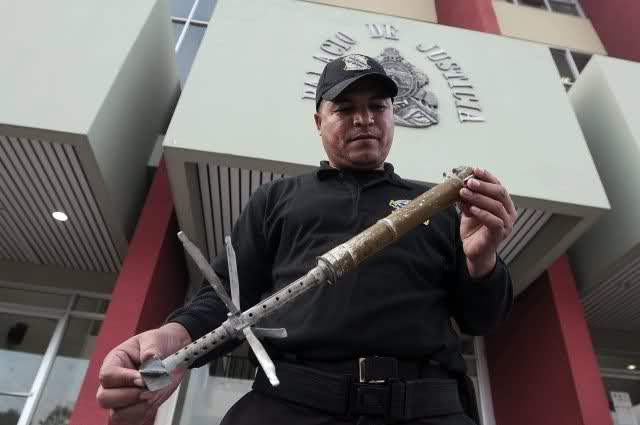
A Honduran policeman displays the remains of an RPG-7 grenade that exploded outside of the Supreme Court building in Tegucigalpa, on 25 November 2009.
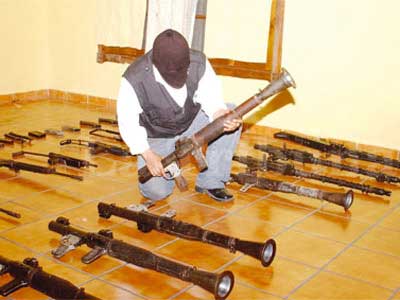
A masked Law Enforcement Officer inspects captured RPG-7s. Note that all four RPGs lack optics and the two MG-34s (sans buttstocks), by his left shin. Photo via Elmundo. See also ‘Mexican Cartel Tactical Notes 11A’. http://smallwarsjournal.com/blog/mexican-cartel-tactical-note-11a
http://elmundo.com.sv/confirman-el-robo-de-22-lanzacohetes-para-rpg7
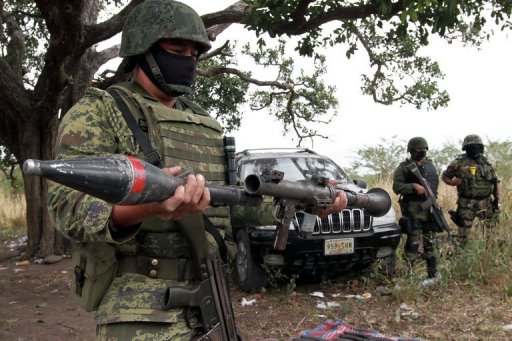
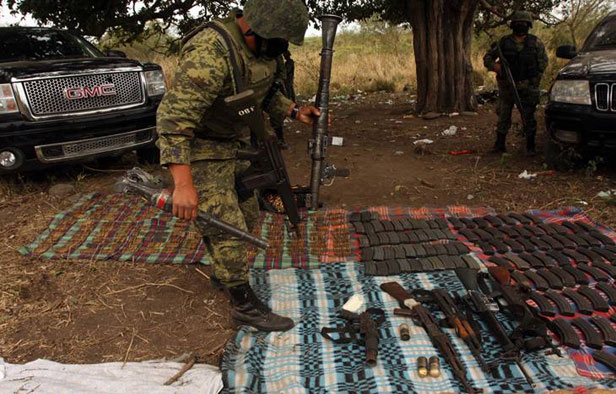
Beat-up RPG-7 launcher and PG-7 rocket confiscated during Mexican Army and Navy operation in "La Antigua", Veracruz, March 2012. Note the lack of optics and missing heat shield.
While only as mechanically sophisticated as a single-action pistol, the RPG’s optics and counter-intuitive flight path through crosswinds requires practice to master beyond point-blank range. Age of and improper storage conditions for the rockets can also negatively affect performance.
Further Reading(s):
Geoffrey Ramsey, “Cable: Honduran Military Supplied Weaponry to Cartels”, Insight Magazine, 25 April 2011
Zetas Guatemala, Insight Magazine, March 02, 2011
http://www.insightcrime.org/criminal-groups/guatemala/zetas/item/628-zetas
RPG-7 Use Throughout Latin America
In addition to weapons stolen from local military depots, ‘legacy weapons’ left over from the Latin and Central American Civil Wars are another likely Cartel source. Since there are no “one way” signs for smugglers, the Mexican Cartels may also tap sources in South America and move them North the same way they move drugs.
The first notable use of the RPG-7 in Latin America was the 1980 assassination of exiled Nicaraguan President Ansatasio Somoza on September 17, 1980. A seven-person Sandinista commando team ambushed his car and killed him near his residence in Paraguay (the first grenade misfired, the second did not).
Over the next decade and a half, guerilla movements in El Salvador, Nicaragua and Guatemala made use of the RPG-7. In 1984/85, Israel supplied the Contras with over a hundred RPG 7s recovered from PLO camps during a 1982 invasion. In a July 1986 memo to CIA Director William Casey, retired Major General John Singlaub discussed a large pending delivery of munitions that included 200 RPG7s. By contrast, exact details on the volume of aid the Soviets supplied their Latin American Allies and friends during the period are far more difficult to pin down.
For instance, a 1986 analysis of 70 tons of munitions seized from rebel caches in Chile revealed that the 114 recently-manufactured RPG7s in mint condition, along with appropriate ancillary equipment, came from Bulgaria. By contrast, a serial number check of the caches’ well-worn M72 LAWs and M16s revealed that they had originally been sent to Vietnam. All of the Chilean cache munitions were suspected of being shipped through Cuba.
In the 1990s, Colombia’s FARC became another customer for RPG7s and Costa Rica a transit point. An RPG-7 and 50 grenades seized in David, Panama by local police in early September 2006 was thought to be related to a shipment of explosives seized the week before in Costa Rica, which originated from Nicaragua and were destined for delivery to FARC (There is also one apocryphal account of a tourist in Costa Rica being offered “an RPG for $75 and rounds for $10 each”).
While these various rebel groups negotiated peace settlements in the early 1990s and supposedly turned in their weapons during disarmament talks, it’s unlikely that the majority went to the smelters. Former guerrillas and downsized soldiers sold or traded excess weapons to Colombia’s FARC, sometimes in barter deals for cocaine.
Possibly some of their caches were forgotten but more likely they were left hidden over the last two decades until cashed-in as a retirement funds. In October, 2011, a farmer digging livestock ponds near Jinotega, Nicaragua uncovered and reported several RPGs (as well 300 AK47s and copious amounts of ammunition).
To help unmask the actual origin of RPGs recovered from Mexican Cartels, local media should be encouraged to photograph the markings and serial numbers.
Significance: Arms Transfer; Cartel TTPs; Cartel Weapons; Cross Border Violence Potentials; SWAT; Urban Combat
Notes: USSOCOM’s General Fraser also pointed out that illicit trafficking by transnational criminal organizations is “expanding between our AOR and the AORs of United States Northern Command, United States Africa Command, and United States European Command, underscoring the truly global nature of this networked threat”.
As the Cartels are becoming more active inside the United States, the most dangerous extrapolation would be proliferation of RPG-7s over the border in the same manner as drugs are smuggled, particularly if the Cartels acquire the more-sophisticated rockets (eg: PG-7VR, PG-7VL, OG-7V, etc ).
The Mexican Army also fields the RPG-29V, known locally as the XGPC-10 and made under license by SEDENA, which when properly handled can be a threat to modern Main Battle Tanks. To date, there have been no open source accounts of these weapons being stolen.
Background Source(s):
Honduran Army Admits Theft of Grenade Launchers, IANS/EFE, February 9, 2012
http://www.laht.com/article.asp?CategoryId=23558&ArticleId=469429
Felix Rivera, ‘About 300 rifles AK, ammunition and launchers discovered’, La Prensa, October 2, 2011
Karl Penhaul, ‘Fear City’, Univision News, September 13, 2011
http://univisionnews.tumblr.com/post/10174024967/fear-city
USA-Mexico Firearms Smuggling, Mexican Federal Government, March 26, 2009
http://www.scribd.com/doc/78384401/01152012
Elmer Enrique Quintero, Decomisan armas de guerra en David, El Siglo, September 16 2006
http://www.panama-guide.com/article.php/20060916171610824
Glenn Garvin, ‘Costa Rica vows effort to stop arms shipments’, Miami Herald, September 15, 2000
http://www.latinamericanstudies.org/costarica/arms.htm
Michael Klare and David Andersen, A SCOURGE OF GUNS : The Diffusion of Small Arms and Light Weapons in Latin America, Federation of American Scientists Arms Sales Monitoring Project , 1996
http://www.fas.org/asmp/library/publications/scourgefl.htm
Analysis of Arms Caches Seized in Chile, August 1986
http://www.fas.org/asmp/campaigns/smallarms/Illicit/Chileaug86.pdf
Jordan Baev , ‘Bulgarian Arms Delivery to Third World Countries, 1950-1989, PHP 27/4/07’, Apr 30, 2007
http://www.ocnus.net/artman/publish/article_28787.shtml
Edward Ulrich , ‘The Astonishing Story of Nicaragua’s Anastasio Somoza’, News of Interest.TV, April 13, 2012
http://www.newsofinterest.tv/politics/book_summaries/anastasio_somoza/index.php
NOTICIAS DE GUATEMALA Weekly Bulletin, August 28 - Sept. 2, 1994
Now available at Amazon.com: Mexico's Criminal Insurgency: A Small Wars Journal-El Centro Anthology by John P. Sullivan and Robert J Bunker.
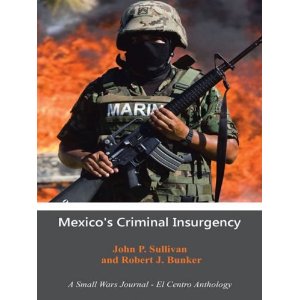
In sum, this anthology represents some of the best and brightest scholars of today who are writing on the evolving security environment in Mexico and the implications this may hold for the United States. They have greatly enhanced our understanding of crime wars and criminal insurgencies-21st century war and conflict waged by non-state entities- and the impact this new form of warfare is having on states. For this, we embrace them and have established the new SWJ El Centro forum to further promote their professionalism and scholarship.
John P. Sullivan, Senior Fellow with SWJ El Centro, is a career police officer. He currently serves as a lieutenant with the Los Angeles Sheriff's Department. He is also a Senior Research Fellow at the Center for Advanced Studies on Terrorism (CAST) and Adjunct Researcher at the Scientific Vortex Foundation in Bogotá, Colombia. His current research focus is the impact of transnational organized crime on sovereignty in Mexico and elsewhere. Collaborative works include Global Biosecurity: Threats and Responses (Routledge, 2010) and Countering Terrorism and WMD: Creating a Global Counter-Terrorism Network (Routledge, 2006).
Dr. Robert J. Bunker, Senior Fellow with SWJ El Centro, is a past senior officer of the Counter-OPFOR Corporation. He is currently adjunct faculty with the School of Politics and Economics, Claremont Graduate University and an instructor with the Los Angeles High Intensity Drug Trafficking Area (LA HIDTA). He has over two hundred publications, including edited and co-authored books, and specializes in terrorism, homeland security, and international security. Collaborative works include Criminal Insurgencies in Mexico and the Americas (Routledge, 2012), Narcos Over the Border (Routledge, 2011), Criminal-States and Criminal-Soldiers (Routledge, 2008), and Networks, Terrorism, and Global Insurgency (Routledge, 2005).